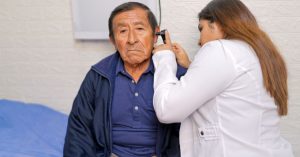Hearing loss often creeps in so gradually that it can go unnoticed until it begins to interfere with daily life. One of the earliest signs that something might be changing in your hearing is the subtle disappearance of certain sounds—often high-pitched ones—that once formed part of your everyday environment. You might find yourself straining to hear birds chirping outside your window, asking people to repeat themselves more often, or missing the ding of the microwave.
These early signs are more than just small annoyances; they are your body’s way of signaling that your hearing health needs attention. Understanding which sounds tend to fade first can help you catch hearing loss early and take action before it worsens. Whether you’re noticing changes in your own hearing or caring for a loved one who seems to be missing parts of conversations, recognizing the first sounds to go is a critical step toward better hearing care.
In this article, we’ll explore why certain sounds are more vulnerable to hearing loss, which specific sounds tend to disappear first, and how these changes can affect daily life. We’ll also look at who is most at risk and when it’s time to seek professional help. Early awareness is key—and knowing what to listen for might just make all the difference.
Why High-Frequency Sounds Go First
When it comes to hearing loss, not all sounds are affected equally. High-frequency sounds—those at the upper end of the hearing spectrum—are typically the first to fade. These include subtle but important noises like the chirping of birds, the ringing of a telephone, or consonant sounds such as “s”, “f”, and “th” that are essential for understanding speech. But why do these sounds disappear first?
The answer lies deep within the inner ear, specifically in a spiral-shaped structure called the cochlea. Inside the cochlea are thousands of microscopic hair cells that are responsible for converting sound vibrations into electrical signals that the brain can interpret. Each region of the cochlea is tuned to respond to different frequencies, with high-frequency sounds processed near the base and low-frequency sounds processed near the apex.
Unfortunately, the hair cells that detect high-frequency sounds are the most vulnerable to damage from aging, noise exposure, certain medications, and underlying health conditions. Once these cells are damaged or die off—which they often do over time—they do not regenerate. This results in the gradual loss of the ability to hear high-pitched sounds.
This process is known as presbycusis, or age-related hearing loss, and it’s incredibly common. In fact, it’s estimated that one in three people over the age of 65 experiences some degree of hearing loss, with high frequencies affected first. While other causes like prolonged exposure to loud environments or ototoxic medications can contribute, the end result is the same: the first sounds to go are often those you don’t realize you’re missing until they’re gone.
Recognizing this pattern helps explain why someone with early hearing loss might struggle to understand speech in a noisy room, even if they can still hear deep voices clearly. The missing high-frequency details make it hard to differentiate between similar-sounding words, leading to confusion, frustration, and social withdrawal.
Understanding the science behind high-frequency hearing loss is crucial, because it sets the stage for identifying early warning signs—and empowers people to take proactive steps before the problem worsens.
Common Sounds People Stop Hearing First
When hearing loss begins, it’s not always obvious—especially because it doesn’t start with loud or jarring changes. Instead, it begins with the quietest, most subtle elements of your auditory world. These are often high-frequency sounds, and they tend to disappear gradually, making them easy to overlook until communication becomes noticeably harder.
One of the first things people often lose is the ability to hear certain consonant sounds. Speech sounds like “s,” “f,” “th,” “sh,” and “ch” are high-frequency and often softer in volume compared to vowels. As a result, people with early-stage hearing loss might say things like “People mumble too much,” or “I can hear, but I can’t understand.” It’s not that they aren’t hearing at all—it’s that they’re missing the crisp edges of words that help distinguish one from another.
Beyond speech, everyday environmental sounds are also commonly affected. These include:
- Birds chirping in the morning
- The beep of a microwave or timer
- The ding of a phone or doorbell
- The rustle of leaves or paper
- Children’s voices, which are naturally higher-pitched than adult voices
Another telltale sign is difficulty hearing in group conversations or noisy environments. Because background noise competes with those already-difficult high-frequency sounds, people with hearing loss often struggle to follow conversations at restaurants, parties, or family gatherings.
These changes might seem small at first, but their impact can grow quickly. Missing a microwave beep might cause a meal to overcook. Not hearing the doorbell could mean missed visits or deliveries. And consistently struggling to follow conversations can lead to embarrassment, social fatigue, and eventually, withdrawal from once-enjoyed activities.
Identifying which sounds are fading is more than just curiosity—it’s a clue to your auditory health. If you or a loved one is finding that these sounds are becoming less noticeable, it’s likely time to seek a hearing evaluation. Catching hearing loss early makes treatment more effective and helps preserve not just your hearing, but your connection to the world around you.
How These Early Signs Affect Daily Life
The early stages of hearing loss may seem minor at first—missing a few high-pitched sounds here and there, asking someone to repeat themselves once or twice. But over time, these subtle shifts can snowball into significant changes that affect communication, emotional wellbeing, and safety.
One of the most common complaints from individuals with early hearing loss is, “I can hear, but I can’t understand.” That’s because high-frequency sounds play a key role in distinguishing between similar words. For example, without clearly hearing the “s” or “th” at the end of a word, “cats” and “cap” may sound nearly identical. This leads to frequent misunderstandings and can make conversations feel exhausting—especially in environments with background noise, like a café or family dinner.
As this difficulty increases, many people begin to withdraw socially, either out of frustration or embarrassment. They might avoid phone calls, decline invitations to gatherings, or stop participating in group activities. Unfortunately, this isolation can contribute to feelings of loneliness and even depression, particularly among older adults.
Hearing loss also introduces safety concerns. Missing warning beeps from kitchen appliances, smoke alarms, or vehicle reverse signals can create real hazards. Similarly, not hearing a doorbell, knock, or someone calling your name can lead to missed connections or emergencies. These aren’t just inconveniences—they can significantly affect your independence and security.
Another subtle but impactful effect is the strain placed on relationships. Loved ones may become frustrated at having to constantly repeat themselves, and the person experiencing hearing loss may feel accused or blamed. Over time, this tension can erode communication and intimacy.
Despite these challenges, many people delay seeking help—sometimes for years—because the changes are so gradual. However, the earlier you address hearing loss, the easier it is to adapt to solutions like hearing aids or assistive devices. These tools can dramatically improve both hearing clarity and quality of life, helping people re-engage with the world around them.
Recognizing how early hearing loss touches all areas of life—from conversations to confidence—is the first step toward reclaiming control and staying connected.
Who Is Most at Risk for Early Hearing Loss
While hearing loss can affect anyone, certain groups are more likely to experience it earlier or more severely. Understanding who is most at risk can help you or your loved ones take proactive steps toward prevention, monitoring, and early intervention.
Older Adults
The most significant risk factor for early hearing loss is age. Age-related hearing loss, known as presbycusis, affects nearly one-third of people over age 65 and half of those over 75. This type of hearing loss occurs gradually and is often tied to the natural wear and tear on the delicate hair cells in the cochlea that help process sound, especially high-frequency sounds.
People with Prolonged Noise Exposure
Long-term exposure to loud noise is another leading cause. Musicians, construction workers, factory employees, military veterans, and even people who frequently use headphones at high volumes can be at increased risk. This condition, known as noise-induced hearing loss (NIHL), can start affecting high-pitched sounds early on and progress if protective measures aren’t taken.
Those with a Family History
Genetics also play a role. If close family members experienced early or age-related hearing loss, you may be more susceptible. Inherited traits can affect how resilient your auditory system is to damage from age or environmental factors.
People with Certain Health Conditions
Chronic conditions like diabetes, hypertension, and cardiovascular disease have been linked to increased risk of hearing loss. These health issues can affect blood flow to the inner ear or damage auditory nerves, making early detection and management crucial.
Medication Users (Ototoxic Drugs)
Some medications are ototoxic, meaning they can damage the inner ear and lead to hearing loss. These include certain antibiotics, chemotherapy agents, and high-dose aspirin or diuretics. If you’re on a long-term medication regimen, especially with known ototoxic drugs, regular hearing checks should be part of your health care routine.
Smokers and Heavy Drinkers
Lifestyle factors like smoking and excessive alcohol use have also been associated with a higher risk of hearing loss. Smoking, in particular, can reduce oxygen supply to the inner ear, making it more vulnerable to damage.
For those in these higher-risk groups, being alert to the first signs—like missing high-pitched sounds or struggling in noisy environments—can make a big difference. Early action often leads to better outcomes, allowing individuals to preserve their hearing and maintain a high quality of life.
When to Get Your Hearing Checked
Recognizing the early signs of hearing loss is important—but acting on them is even more crucial. Unfortunately, many people wait years before seeking help, often because the changes happen so gradually that they don’t seem urgent. Yet early intervention can make a significant difference in preserving hearing, improving communication, and maintaining overall well-being.
You Notice You’re Missing High-Frequency Sounds
If you’re struggling to hear birds chirping, electronic beeps, or the voices of women and children, it’s a clear signal that something may be changing in your hearing. These high-pitched sounds are often the first to go and can serve as an early warning sign.
You Often Ask People to Repeat Themselves
Frequently saying “What?” or “Can you repeat that?”—especially in noisy environments—is a classic red flag. It’s not just about volume; it’s about clarity. If you can hear people talking but can’t make out their words, a hearing evaluation is warranted.
Conversations Feel Exhausting or Frustrating
Straining to understand speech, particularly in group settings or crowded places, can lead to mental fatigue and frustration. If listening feels more like work than it used to, it’s time for a hearing check.
Loved Ones Have Noticed Changes
Often, those around you will notice hearing changes before you do. If family or friends have mentioned that you seem to be missing things or turning the TV volume up higher than usual, take their observations seriously.
You Have Risk Factors
If you’re over 50, have a history of noise exposure, or live with conditions like diabetes or high blood pressure, regular hearing screenings should be part of your routine healthcare. Catching changes early allows for better treatment and adjustment to hearing aids or assistive technology.
What to Expect During a Hearing Test
Getting your hearing checked is a simple and painless process. An audiologist or hearing specialist will start with a few questions about your symptoms and health history, then conduct tests to measure your hearing ability at various frequencies. The results will be charted on an audiogram, which shows exactly which sounds you may be missing.
If hearing loss is detected, your provider will discuss next steps, which may include hearing aids, communication strategies, or other assistive technologies. Today’s hearing aids are discreet, highly advanced, and customizable—offering more options than ever before.
Being proactive about your hearing isn’t just about the sounds you hear; it’s about staying engaged, connected, and confident in your daily life. If you suspect something has changed, trust your instincts and get tested. The sooner you know, the sooner you can take action.
Conclusion
Hearing loss often begins quietly—so quietly, in fact, that many people don’t realize it’s happening until it starts to interfere with conversations and daily routines. The earliest signs usually involve missing high-frequency sounds like birdsong, electronic beeps, or the sharp consonants that give speech its clarity. These may seem like minor inconveniences, but they are critical clues that your hearing health may be changing.
The good news is that early detection can make a huge difference. By recognizing which sounds typically fade first, you can take timely steps to protect your hearing, maintain strong communication with loved ones, and preserve your overall quality of life. Whether you’re over 50, frequently exposed to loud environments, or noticing subtle shifts in how you hear the world, it’s important not to dismiss the signs.
Modern hearing evaluations are quick and painless, and treatment options have come a long way. From nearly invisible hearing aids to assistive devices tailored to your lifestyle, there are solutions that can help you stay engaged and confident.
Don’t wait until the problem becomes overwhelming. If you or someone you care about is starting to miss sounds that used to be part of everyday life, consider it a signal—not just of hearing loss, but of an opportunity to take charge of your health.
FAQ
What are the very first signs of hearing loss?
The earliest signs of hearing loss often involve difficulty hearing high-frequency sounds, such as birds chirping, beeping appliances, or soft consonants like “s” and “th” in speech. People may also begin to struggle with understanding conversations in noisy environments or feel that others are mumbling.
Why do high-pitched sounds disappear first?
High-pitched sounds are processed by hair cells located at the base of the cochlea, which are more susceptible to damage from aging, noise exposure, and certain medications. Once these cells are damaged, they cannot regenerate, leading to a gradual loss of high-frequency hearing.
Can I prevent high-frequency hearing loss?
While age-related hearing loss isn’t fully preventable, you can reduce your risk by avoiding prolonged exposure to loud noises, using hearing protection, managing chronic health conditions like diabetes or high blood pressure, and avoiding ototoxic medications when possible.
Is hearing loss reversible if caught early?
Most forms of sensorineural hearing loss, including high-frequency loss, are not reversible. However, catching it early can help slow progression and improve outcomes with hearing aids or other assistive technology. Early intervention is key to maintaining communication and quality of life.
When should I get my hearing checked?
You should get your hearing checked if you notice you’re missing certain sounds, struggling to follow conversations, frequently asking people to repeat themselves, or if loved ones mention changes in your hearing. People over 50 or with risk factors should have regular hearing screenings.
This article is for informational purposes only and is not a substitute for professional medical advice, diagnosis, or treatment. If you are concerned about your hearing or ear health, please consult a qualified healthcare provider.





